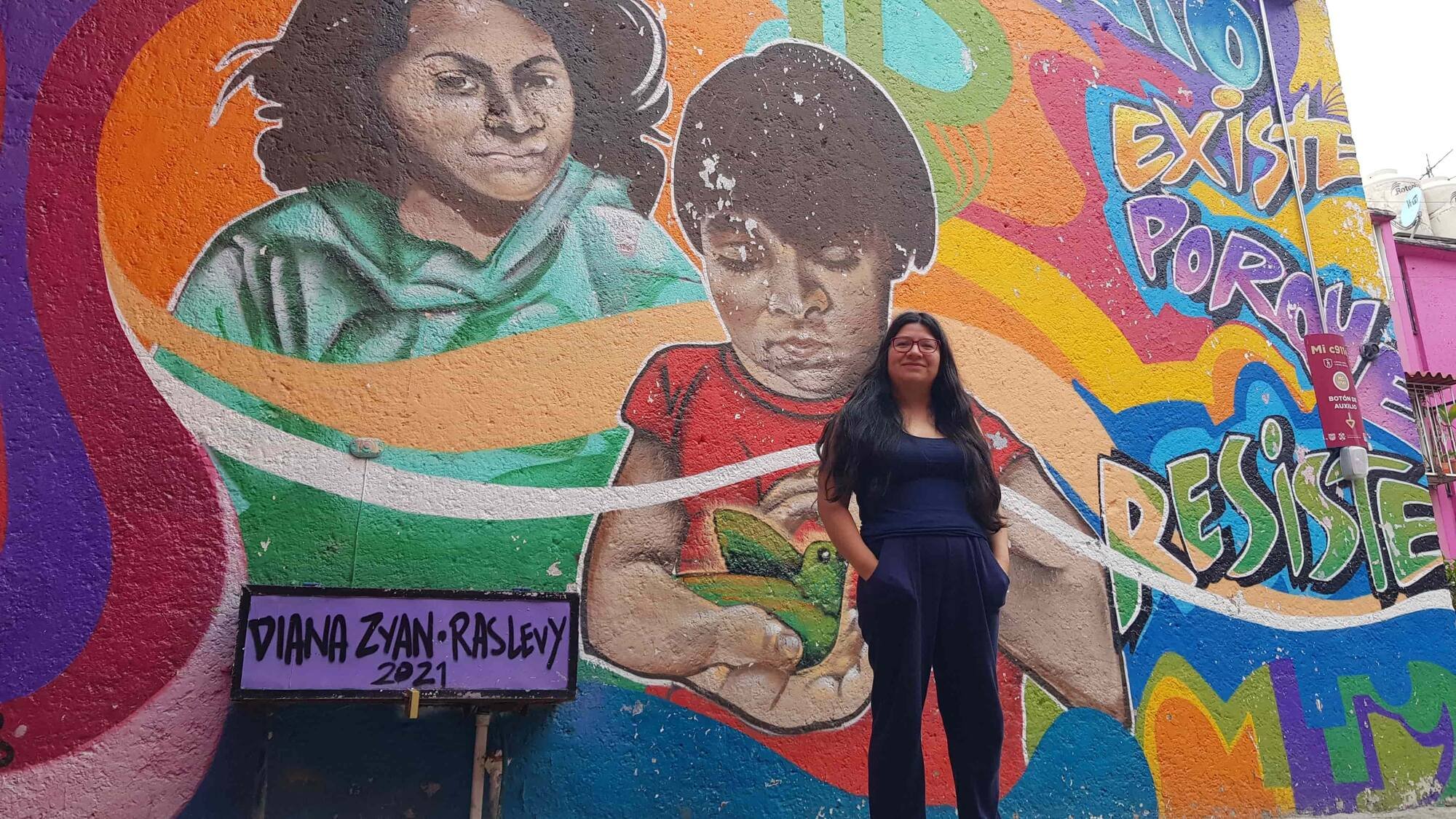In Mexico City, ‘the barrio is coming together’
Eme Malafe, in a classroom at the National Arts Center, in southern Mexico City. Photo: María José López.
Reportage • María José López • November 10, 2023 • Leer en castellano
Late into the evening on Sunday, July 16th, tens of thousands of youth on motorcycles rode from all over Mexico City to gather on a corner in the colonia of Buenos Aires, near downtown.
Buenos Aires is known for being a hub for the sale of stolen car parts, and it was there that Eme Malafe gave a historic concert on the rooftop of a supermarket. The massive rally and concert were organized under the slogan “Todos Somos Un Solo Barrio” (We Are All One Neighborhood). In Mexico, “barrio” refers to a working-class, urban or suburban neighbourhood, often marginalized, that has a particular history and identity.
The July 16 event was the second concert organized by Mexican musician Martín Geovanni Aldana Cervantes, who uses the stage name Eme Malafe. The first, on March 5, 2021, was much smaller, but the consequences were far more severe: around 300 people were arrested, 130 were charged, and hundreds were beaten. Organizing a major event by the barrio, for the barrio, in the barrio, is no simple matter.
“We weren’t even fighting for anything... publicly. It’s more like, ‘look at that guy, he’s from the barrio just like me, he’s also strapped for cash, he’s also working his ass off to support his family,’” Eme Malafe told me in an interview at the National Arts Center, where he takes music classes. “That’s why we used the slogan of Todos Somos Un Solo Barrio, the idea is to help each other, not to bring each other down.”
Everybody wants to be from the barrio, until it’s time to be from the barrio
Working-class neighborhoods throughout Mexico face harsh inequality, dispossession and poverty, while their symbols, codes and expressions are becoming increasingly prominent in Mexican culture.
Some of the country's most important musical acts are from barrios, like El Bogueto, from Neza, and El Malilla, from Valle de Chalco, both in the State of Mexico; Bellakath, from Agrícola Oriental, in the capital; or Santa Fe Klan, from Santa Fe, in the capital of Guanajuato state.
Eme Malafe grew up in the colonia Morelos, a few blocks north of the capital’s Zócalo (in Mexico, a colonia is a subdivision of a municipality). That’s where the barrio bravo (rough neighborhood) of Tepito is located, known for having one of the most important street markets in Mexico, and also for the violence experienced by its residents. Since the 1970s, the economic changes that preceded neoliberalization impacted the barrio even more.
Music was not part of Eme Malafe’s upbringing. He came to it during college, when he began to blend his interest in writing and improvisation with his taste for music. That’s when he wrote “Pa’ correr nacimos” (“Born to run”), a song about the street racing community.
Since then, he has expanded his musical range from hip hop to salsa, merengue, corrido and reggaeton; he defines his music as a “party in a barrio in Mexico City.” Throughout his work, he depicts the stark reality and resistance of those who live and die in similarly difficult contexts.
Ten years ago, a new phenomenon started to torment the sellers of Tepito: the “cobro de piso” (extorting money in exchange for protection) and the logic of territorial control of organized crime groups, which has grown since the launch of the “war on drugs.”
Despite the precarious social fabric, being from the barrio has never been as attractive as it is today. Agencies have started to offer tours for foreigners to visit the "fierce" neighbourhoods in Mexico City's downtown, even taking tourists inside low income housing complexes.
“There are still so many movies, TV series and soap operas that use Tepito as a setting to tell stories that reinforce stereotypes about its residents,” Pedro Joaquín, a young actor and shopkeeper who was raised there, told me. “It’s very upsetting as an actor who has lived in the barrio, to see how we’re depicted, as an exaggerated caricature.”
Joaquín is collaborating with the fifth edition of the Festival de Cine de Barrio (Barrio Film Festival, FECIBA), which will be held in the adjacent barrios of Tepito, La Merced and Peralvillo, with the intention of turning cinema into a local activity and making it accessible to communities excluded by the cultural industry. “I think it’s sad that producers and directors have such a narrow and morbid vision of the barrio, only telling stories about violence or drug trafficking,” he told me after a day of filming his fellow shopkeepers for the festival’s promotional trailer. “Tepito is so much more than that.”
Actor and shopkeeper Pedro Joaquín, at the entrance of Peralvillo 22, in Mexico City’s Morelos neighborhood. Photo: María José López.
The FECIBA, which will take place from November 21-26 this year, defies many conventions, starting with the lack of glamorous red carpets. “The festival showcases films made by filmmakers from the barrio and films that address issues in the barrio, which are rarely made visible, and it’s held in a different barrio each year,” said Joaquín. In past editions, the festival has been held in Tláhuac, Iztapalapa, Xochimilco and Neza, in greater Mexico City. “It arrives in Tepito precisely at a time when the barrio is undergoing an intense wave of exoticization and gentrification.”
Growing up in the barrio
For almost 30 years, Susana Meza, a member of the theater troupe of the Tepito Arte Acá collective, has worked to break down barriers that prevent residents of the barrios from participating in the arts.
“Through constant work, we’ve done a lot of projects here, both performances and workshops in the streets, in schools and in spaces like this one,” she said. She’s talking about Peralvillo 22, a housing unit in the colonia Morelos, where I interviewed her in October. There, the collective project Isla de Paz (Island of Peace), a playground for children with continuous educational, recreational and artistic activities, is run by mothers, grandmothers and aunts from the neighborhood.
Last January, children from Tepito presented artwork they created in an engraving workshop hosted by Tepito Arte Acá at the Contemporary Mexico Cultural Center. “The kids began to see themselves not as audience but as the performers, as the ones in the spotlight,” Meza told me.
Susana Meza from the Tepito Arte Acá collective in Peralvillo 22, in Mexico City’s Morelos neighbourhood. Photo: María José López.
Children and teens are central to Eme Malafe’s creative process. Although his art sometimes portrays violent situations, criminal acts, firearms and death, he’s mindful of what’s at the heart of his message. “The goal of Todos somos un solo barrio was to get them to feel proud of belonging to a barrio, to stop hiding, to stop wanting to be the bourgeois people they were never going to be,” he said.
After six years in the music business, Malafe is satisfied because he sees that his art is resonating with the young audiences he wants to connect with.
“I know when I can reach the morros (young people) and when I can’t,” says Malafe. “At the end of the school year, I get messages from the morros with a photo of their diplomas, saying ‘look man, I finished school, I made it! Hey man, I’m dedicating my diploma to you.’”
Coming down, not looking up
Faced with an onslaught of gentrification, criminalization and silencing, residents of barrios throughout Mexico are turning to each other and amplifying their voices. “Now is the time for the people living in the barrios to be the authors of our own stories, to truly express our own concerns, the issues we deal with, and our view of the world,” Joaquín reflects.
These projects are popping up in the heart of Mexico City, and are built collectively by residents from the bottom up, subverting the individualistic and extractivist practices they know all too well.
“The Festival de Cine de Barrio holds workshops and seminars related to the exhibition and accessibility of film for vulnerable communities and populations,” said Joaquín. “For example, there’s the ‘Seminar for projecting in the barrio,’ for people with film club projects, or the ‘Directing the Gaze’ workshop, which trains those interested in writing and recording audio-description and interpreting in Mexican Sign Language, in order to make films accessible to people with disabilities and the Deaf community.”
In a housing complex in Tepito, the FECIBA team films Víctor Hugo Rodríguez and Jesús Barreto “El Chino,” sellers of cholo style apparel, for the festival’s promotional trailer. Photo: María José López.
For Eme Malafe, a key strategy for bringing together people from so many different barrios without sparking conflict between them was to reach out to another stigmatized sector of Mexican society: motorcycle riders.
“Among people in the motorcycle community there’s an understanding that when you see someone fall off their bike, you stop and say, ‘hey bro, let me give you a boost. How can I help you? Are you out of gas?’ You just do it, because you’ve been there too,” he says. “We’re in a moment in which motorcyclists are looked down upon. We started to show a more positive side to riding bikes. Why are there people who don’t like to see so many of us coming together?”
Encouraging self-recognition and celebration of life in the barrios is, for Eme Malafe, the most important tool to start creating a different way of connecting and enjoying life.
“We don’t have a lot of opportunities, but what opportunities do we have? What are we really good at?” asked Malafe. “Let’s celebrate where we’re from, and show everyone we can have fun together.’”





